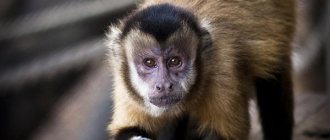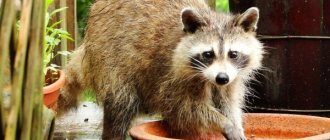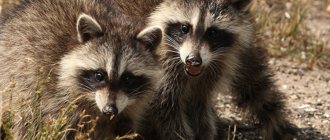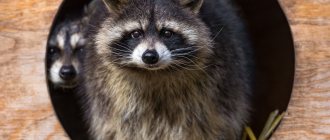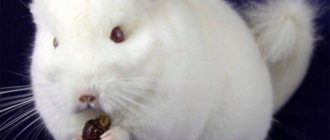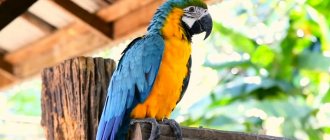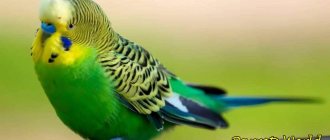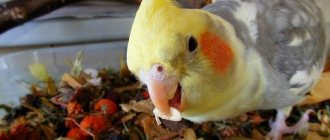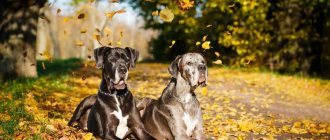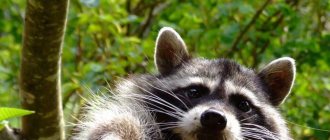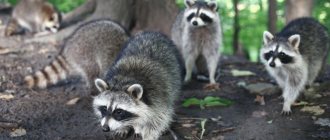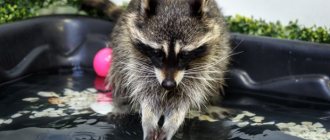The striped raccoon, or American raccoon [1] (lat. Procyon lotor), is a predatory mammal of the raccoon genus of the raccoon family. One of the few species that thrive under conditions of increasing anthropogenic impact, expressed in the gradual cultivation of land[2]. The raccoon takes root well in places of introduction, although it is generally a heat-loving species. On the territory of Russia, the species has well established itself in the western (Black Sea) and eastern (Caspian) regions of the North Caucasus, where it has become a dangerous invasive species that threatens local flora and fauna[3]. In Belarus it has taken root well in Polesie. The raccoon is easily tamed and suitable for breeding in captivity[4].
Distribution[edit | edit code]
The striped raccoon is distributed in North America, from the Isthmus of Panama to the southern provinces of Canada.
Its acclimatization was carried out in Germany and in the territory of the former Soviet Union (most successfully in the south of Belarus and Azerbaijan); From the release points, the raccoon moved to France and other European countries.
In the USSR, raccoon acclimatization was carried out in the 1930s in Primorye, then again in the 1950s and 1980s in a wide strip in the European part of Lithuania, Belarus, Donbass, Ciscaucasia, the Caucasus and Azerbaijan. Animals were also released in Central Asia (Kyrgyzstan) and again in Primorye. In 1936, the North American striped raccoon[5] was acclimatized in the walnut forests of Arslanbob (Kyrgyzstan), where it willingly colonized walnut hollows[6]. The raccoon has also spread widely in the Volga delta[7].
Dagestan[edit | edit code]
The raccoon has well mastered the tugai forests in the Terek and Sulak basins with an area of more than 120 thousand hectares. The beast has successfully developed the lands of the Magaramkent, Derbent and Kayakent regions of the Republic of Dagestan. The Terek-Sulak raccoon population lives in island floodplain forests along the Sulak and Terek with a very small number of large trees. As their numbers increase, the animals also occupy foothill forests. They also fell in love with the subtropical Samur delta.
Krasnodar region[edit | edit code]
In the Western Caucasus, the raccoon has best mastered the forests of the Krasnodar Territory. By the 1970s, the total area of raccoon settlements in the Krasnodar Territory reached 780 thousand hectares. Here, raccoons settled not only in the floodplain forests, but also went quite high into the mountains, for example, in the region of the city of Indyuk. However, the species here demonstrates a pronounced pulsation of numbers and range. Depending on factors such as the season of the year, amount of precipitation, harvest or failure of food, the raccoon migrates from mountainous areas to floodplain, coastal and valley forests, and vice versa. The raccoon has long populated the forests along the left bank of the river. Kuban and the entire Black Sea coast from the city of Novorossiysk - st. Erivanskaya to st. Dakhovskaya - to the village of Bolshoi Kichmay. The species is most well established in the upper reaches of the river. Psekups, along the river valley Pshish and through the forests of almost all mountain rivers flowing into the Black Sea. In some places he also developed the suburbs (Tuapse), parks and forest parks of smaller settlements. Like the gray rat, if it reproduces uncontrolled, a raccoon can turn into a malicious pest of the local fauna and spread diseases in unsanitary conditions of garbage and landfills. But its numbers in the Russian south are limited by another species actively spreading here - the common jackal. In 1967, jackals appeared in the forests of Urup (Penzikov, 1983). In January 1968, the first specimen was killed here. In 1969, 5 animals were killed in the Urupsky region, in 1970 - 6, and in 1971 already 9. The appearance of jackals led to a reduction in the number of hares, and there were almost no introduced raccoons left in the Urupsky region[8].
Diet
Raccoons are carnivorous mammals, but they are actually omnivores. The diet of these agile animals shows a seasonal change in food.
In spring and summer, raccoons eat mainly animal food. Having descended from the trees, they move slowly along the ground and often stop, trying to find something edible. Raccoons react instantly to various small animals. In autumn, animals prefer food of plant origin.
The basic diet of raccoons includes frogs, insects and their larvae, crayfish, crabs, snails, earthworms, and rodents. Sometimes they eat reptiles and love to feast on bird eggs. From plant foods, raccoons eat berries, nuts and acorns, and fruits. The animals collect wild cherries and elderberries, gooseberries, and wild grapes. From time to time they also eat garden crops - grain, potatoes, corn. During a drought, they do not disdain chicks; they can visit chicken coops. Sometimes raccoons raid the nests of dangerous insects (hornets, bumblebees, ants, termites). Thick skin and thick fur reliably protect animals from stinging bites. Raccoons eagerly eat the larvae they find in nests. These predators are one of the few who get their food in three elements - on land, in water and air.
Interesting fact
Raccoons living in suburban areas near people often inspect the contents of garbage cans.
Since it is difficult to smell prey in the dark, animals hunt in the aquatic environment a little differently than on land. Raccoons dip their paws into the water to examine the soil and snags. When sensitive fingers have found the prey, predators instantly grab the victim and rinse it repeatedly in water. Raccoon raccoons do this especially carefully. This is how they determine whether the food is ready to eat.
Interesting fact
A huge amount of speculation is caused by the desire of raccoons to rinse food before eating. Previously, zoologists assumed that the body of predators produced too little saliva, as a result of which there was a need to wet the prey. However, this assumption was refuted.
The most plausible explanation is considered to be a genetic imitation of catching prey from the water in raccoons.
Raccoon in the forest
Lifestyle and nutrition[edit | edit code]
Mixed forests with old hollow trees and the presence of ponds or swamps are most suitable for the striped raccoon. He avoids coniferous forests, as well as forests without bodies of water. In the south of its range it is found on the sea coast. Raccoons easily adapt to the anthropogenic landscape, settling on the outskirts of fields, in gardens, and often in cities and suburbs. The raccoon makes its home (often several) in hollows. As a last resort, it uses ground shelters - crevices in rocks, badger holes; He doesn’t know how to dig holes himself. Leads a twilight-nocturnal lifestyle; spends daytime hours in the den. It goes fishing at dusk, walking around its area (with a radius of up to 1.5 km) in search of food. A raccoon rarely moves more than 1.5 kilometers from its home. In this case, the areas of individual individuals often overlap each other, and, as a result, the density of raccoons in the areas can be quite high[6].
The striped raccoon deftly climbs trees; very tenacious fingers allow it to hang, clinging to a horizontal branch, or go down the trunk upside down. Thanks to excellent night vision and vibrissae, tufts of which are located not only on the head, but also near the claws, on the inside of the limbs, on the chest and stomach, the raccoon can gallop confidently even in complete darkness. The only representative of the raccoon family that goes to sleep for the winter. Sleep is shallow and intermittent. In Canada it lasts 4-5 months; in the southern regions the raccoon often does not fall asleep at all. Sometimes up to 10 individuals gather in large hollows for the winter.
Unusual pets
Increasingly, people began to keep raccoons as pets. These cute animals are distinguished not only by their external charm, but also by their very difficult character. They are independent, intelligent and brave, so taming them will require some skill. If a raccoon lives in your house, then the absence of boredom is guaranteed. The rogue will definitely check all the cabinets and pull out goodies from them.
The predatory nature will not allow the raccoon to be kept together with small animals and birds, but it gets along well with cats and dogs. Communication with a predator is contraindicated for small children, because the animal bites and scratches strongly.
It is important to monitor what a raccoon eats, because at home it can uncontrollably absorb any food. If you follow all the maintenance rules, the life expectancy will be over 15 years.
Economic importance[edit | edit code]
The striped raccoon is a valuable fur-bearing animal. The first experiments on its breeding in the USSR were carried out in 1936, in the Caucasus, Central Asia, Belarus and the Far East. In Azerbaijan, the most successful raccoon acclimatization was in the Zakatala-Nukha Valley. The striped raccoon did not take root in the Primorsky Territory, although it existed here from 1937 to 1976[12]. After 1954, 486 raccoons were released in Primorye. But the raccoon dog turned out to be a strong competitor to the raccoon in the fight for local resources. The Far Eastern charza also appears to have been a factor in the failure of raccoon naturalization[6].
In the USA, the raccoon is a commercial species. In North America, under the most optimal conditions, the density of the species reaches 300 individuals per 1000 hectares: then raccoons often destroy fields, orchards, vineyards, melon fields and chicken coops, damaging farms. In Transcaucasia and Dagestan, raccoon density in some areas ranges from 20 to 30 individuals per 1000 hectares.
The animal can also be successfully bred in captivity. Animals with the sign of samson (cotton hair), which is a congenital defect in which matted downy hair is observed due to poorly developed awns, are culled.
Raccoon sleeping at home
If a raccoon lives at home with a person, then it does not need hibernation. The temperature at home is always the same. If he wants to take a nap (instinct will take over), he will fall asleep for a maximum of a couple of weeks.
This can happen in particularly severe frosts, when it can be felt even in a warm apartment. If your raccoon falls asleep, you should never wake him up. The animal's body knows better when to sleep. You can make a “mini house” for a raccoon. Cover it with a blanket ring to make the animal more comfortable. Better yet, don't even touch it.
After a nap, you may notice your pet's slight disorientation. This can be compared to how you feel in the morning. Don't worry, it will go away in an hour or two.
But after such a “mini-hibernation” the raccoon will be active and alert for a long time. The animal stores up its strength and its body, being cleansed, becomes better and stronger. After waking up, the raccoon is usually hungry, so it is worth feeding it.
Classification[edit | edit code]
Currently, there are 22 subspecies of the striped raccoon (Procyon lotor)[13][14], including several island endemics, one of which became extinct in the middle of the 20th century:
- P. lotor auspicatus
- P. lotor elucus
- P. lotor excelsus
- P. lotor fuscipes
- P. lotor gloveralleni – Barbados raccoon†
- P. lotor grinnelli
- P. lotor hernandezii
- P. lotor hirtus
- P. lotor incautus
- P. lotor inesperatus
- P. lotor insularis – Tresmarias raccoon
- P. lotor litoreus
- P. lotor lotor
- P. lotor marinus
- P. lotor maynardi – Bahamian raccoon
- P. lotor megalodous
- P. lotor pacificus
- P. lotor pallidus
- P. lotor psora
- P. lotor pumilus
- P. lotor simus
- P. lotor vancouverensis
Tropical raccoons, greetings from Panama
Does a raccoon hibernate where warm weather prevails? – It does, but in rare cases. In regions where the temperature does not drop below +12° (C), raccoons are not prone to winter hibernation. Only a slight decrease in physical activity, which will be noticeable only to an experienced eye, reminds us of the ancient and archaic instinct of hibernation.
Raccoons in this climate zone are light in weight and have light hair. If you put a northern and a tropical raccoon side by side, the difference will be enormous. In fact, the tropical raccoon has become an independent subspecies. These animals are called crustacean raccoons. Unlike the striper, the crayfish has almost smooth fur. It's all about the climate. The tropics are the warmest climate zone. There is no need to protect yourself from the cold with a layer of fat and thick wool.
Winter in the tropics is characterized by heavy rainfall. Do raccoons hibernate during weeks of heavy rain? – Scientists have not observed hibernation. The only thing is that the raccoon can simply wait out the vagaries of nature in its cozy nest. That is, during the rainy season, a raccoon can doze in the hollow of its tree, waiting for good weather.
What about pet raccoons?
Regarding raccoons from northern latitudes, if a pet lives in an outdoor enclosure, it will certainly hibernate. Do raccoons hibernate while living with their owners under the same roof? - No. Living in warm conditions, raccoons are not prone to winter hibernation. The only thing that can remind you of hibernation is a decrease in physical activity.
Source
Notes[edit | edit code]
- ↑ Sokolov V. E. Five-language dictionary of animal names. Mammals. Latin, Russian, English, German, French. / under the general editorship of academician. V. E. Sokolova. – M.: Rus. lang., 1984. – P. 97. – 352 p. – 10,000 copies.
- ↑ Alien species on the territory of Russia: Invasion of alien species: Mammals: Procyon lotor - Raccoon
- ↑ Hunters: raccoons and jackals threaten Sochi | Max Portal
- ↑ Emnr-Onknyaysm
- ↑ Raccoon Raccoon | Natalia Butrina's blog
- ↑ 1 2 3 Library - Rukovsky N.N. - In the footsteps of forest animals - Raccoon Raccoon - St. Petersburg Hunter, website about hunting, forums hunting, weapons, fishing, dogs, cartridges, animals, electronic...
- ↑ Club "Astrakhan Trophy". Raccoon Hunt
- ↑ Jackal Hunting
- ↑ BBC series: Life of Mammals. Episode 6 (inaccessible link). Access date: September 2, 2012. Archived August 3, 2012.
- ↑ Hunting the jackal.
- ↑ enot-doma.ru. How long do Raccoons live? Raccoon at Home.
- ↑ Who are raccoons?
- ↑ Procyon lotor Archived May 21, 2011 on the Wayback Machine in Wilson DE, Reeder DM (editors). 2005. Mammal Species of the World. A Taxonomic and Geographic Reference (3rd ed.). – Baltimore: Johns Hopkins University Press, 2 vols. (2142 pp.) ISBN 978-0-8018-8221-0. OCLC 62265494.
- ↑ Raccoon (English) according to the Integrated Taxonomic Information Service (ITIS).
Raccoons of the middle climate zone, greetings from the USA
Animals of mid-latitudes are less prone to winter anabiosis. Do raccoons hibernate? - Yes, they do. But, an amendment needs to be made here. The depth of sleep in raccoons from this climate zone is quite superficial. There are cases when raccoons are walking around the area already in early February. That is, if the weather is sunny and windless outside, the raccoons wake up and go out to warm up.
Of course, in winter the activity of raccoons noticeably decreases. Instead of brawls and hooligan antics, raccoons lead a modest lifestyle, recovering from winter suspended animation. A raccoon that hibernates can sleep for up to 4 months in incomplete suspended animation. That is, any warming wakes up raccoons, which makes sleep shallow and too intermittent. If the winter is warm enough, raccoons may not sleep at all. In this case, hibernation will only be reminded of by a decrease in the physical activity of these animals.
Preparing for hibernation in raccoons from the middle climate zone
This region is home to average raccoons. Unlike their northern counterparts, this family of raccoons does not need to accumulate a protective layer of fat. Of course, raccoons gain weight by winter, but the volume of subcutaneous fat is incomparable with the level of fat deposits of northern raccoons. The same can be said about wool. Raccoon fur is not as thick and fluffy as that of its northern counterparts.
Animals in winter
Wild animals spend the cold period in different ways. Hares change their gray coats to white so that predators do not notice them in the snow. They jump along forest paths, eat twigs and tree bark, and take dry grass out from under the snow. The fox also grows a warm fur coat for winter. In the cold months, she feeds on mice, birds, hares, and steals chickens from chicken coops.
In summer, squirrels prepare their supplies in deep tree hollows. Thanks to this, in times of hunger they can easily find food for themselves. When cold weather sets in, the animals climb into their nests. Squirrels are in a semi-dormant state in winter and only come out to eat. Their fur coats also change color, they turn grey.
In winter, many rodents fall asleep. The exception is moles, which, due to their high metabolism, cannot go without food for a long time. The diet of these animals consists mainly of earthworms and insect larvae. To find food, moles dig holes at a depth of 5-10 cm. In the summer, they make provisions for the winter: they hide worms and larvae in certain places underground. When cold weather sets in, moles do not lose activity: they dig the ground, eat stored insects and look for new ones. In severe frosts, when the ground freezes, it becomes difficult to find food, so many of them die of hunger.
Animals that hibernate prepare for cold weather in advance. In order to safely survive a difficult period, in the summer they actively feed, accumulate fat reserves, and prepare shelters.
